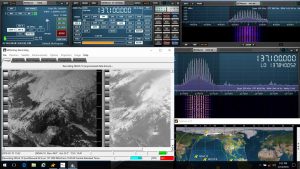Joe over at USA-Satcom has now updated his popular XRIT and XHRPT software to control the new RSPdx. (The XRIT and HRPT software already supported the RSP1A, RSP2, and RSPduo). These software packages are used to decode data from the NOAA and GOES weather satellites and also MetOp-A/B, FengYun-3A/B/C and Meteor M2/M2-2.
Here are some pictures, courtesy of RSP2user, to whet your appetite:

Above: XRIT software with an RSPdx receiving GOES 17 signals
Below: Using the XHRPT software with an RSPdx receiving Meteor MN2-2

The software is not free, but can be licensed for a modest fee, contact Joe for further details: https://usa-satcom.com or email him at rfnoise(at)gmail.com
The equipment requirements are quite modest too, especially for the GOES satellites which are geostationary. Here is an off-the-shelf antenna (slightly modified), combined with a Nooelec SAWbird GOES LNA with filter and an RSPdx (courtesy RSP2user):

Above: The modified (readily available) wi-fi grid antenna
Below: close-up of the RSPdx and Nooelec filter/LNA

Antenna: http://www.premiertek.net/products/networking/ANT-GRID-24dBi.html (Modifications are discussed in note 6 below)
SAWbird GOES 1.688 GHz LNA with Filter (powered from RSP Bias-T): https://www.nooelec.com/store/sdr/sdr-addons/sawbird/sawbird-goes-305.html
SAWbird IO Inmarsat 1.542 GHz LNA with Filter (powered from RSP Bias-T): https://www.nooelec.com/store/sdr/sdr-addons/sawbird/sawbird-io.html
Notes:
1. For the NOAA, Meteor (M2 and M2-2), Fengyun, and Metop satellites on L-band for HRPT images, the same Nooelec 1.688GHz LNA with filter is applied. USA-Satcom has XHPRT software available for a fee for demodulating HRPT signals.
2. For the NOAA and Meteor orbital satellites at 137MHz there is also this Nooelec LNA with filter: https://www.nooelec.com/store/sawbird-plus-noaa-308.html. A suitable 137MHz antenna is described here: https://sdrplay.com/community/viewtopic.php?f=5&t=2529&p=10239&hilit=NOAA+APT#p10239
3. For Inmarsat AERO/STD-C at 1.542GHz: https://www.nooelec.com/store/sdr/sdraddons/sawbird/sawbird-io.html
4. Capturing GOES and HRPT satellite images requires the previously mentioned specialized software from USA-Satcom.
5. The NOAA APT images at 137MHz (NOAA 15, 18 & 19) can also be captured using SDRuno in conjunction with WXtoImg and Orbitron (for manual capture):
6. A full description of this setup for GOES satellite image reception can be found in the SDRplay community forums archive here: https://sdrplay.com/community/viewtopic.php?f=5&t=3262
7. For HRPT image reception, there is an article here: https://sdrplay.com/community/viewtopic.php?f=5&t=2624
8. For APT image reception, there is an article here: https://sdrplay.com/community/viewtopic.php?f=5&t=2529&p=10239&hilit=NOAA+APT#p10239

Above: Recording NOAA 19 using SDRuno and WXtoIMG
Related links:
WXtoImg: https://wxtoimgrestored.xyz
Orbitron: http://www.stoff.pl
In addition you will need virtual audio cable software (VAC or VBcable are popular) to send audio from SDRuno to WxToImg, and Virtual COM port software (e.g. Com0com, VSPE or VSPD) to exchange control signals between the two. These are covered in application notes in the SDRplay Video and Applications Catalog here: https://sdrplay.com/apps-catalogue/
You can check out one of the high resolution GOES images by downloading an example received from GOES16 here: (note this is 48MB data!)
The resolution is so great you can zoom in for further detail, for example here is the eye of a recent hurricane!

There are so many uses for your RSP beyond SWL and the regular ham bands, expand your horizons and give it a try!
Go to https://sdrplay.com/apps-catalogue/ to download this article and many other useful applications articles.
If you would like to publish an article about the application of an RSP in conjunction with other products, then please email Jon dot Hudson at SDRplay.com – we would be happy to consider posting a link to it in the catalogue.
